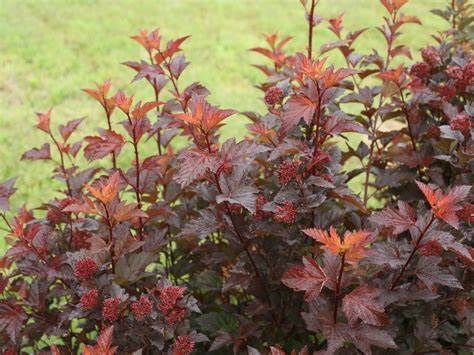Riverdene Garden Center
Ginger Wine Ninebark
Ginger Wine Ninebark
Couldn't load pickup availability
Physocarpus opulifolius ‘Ginger Wine’
Ginger Wine® Ninebark is a cold-hardy, disease-resistant deciduous shrub known for its rich orange-red spring foliage, soft pink-white flowers in early summer, and warm burgundy tones in fall. It is a vigorous, low-maintenance shrub that is drought-tolerant and highly adaptable, making it an excellent choice for hedges, specimen plantings, and mixed borders in Southwest Saskatchewan.
Planting & Location
- Hardiness Zone: 3-7 (exceptionally winter-hardy, ideal for prairie climates)
- Mature Size: 5-6 feet tall, 5-6 feet wide
- Growth Rate: Fast (12-24 inches per year)
- Sunlight Needs: Full sun to partial shade (best foliage color in 6+ hours of direct sun)
-
Soil Preference:
- Prefers well-drained, loamy soil.
- Tolerates clay, sandy, and slightly alkaline soils.
- Avoid waterlogged conditions, as Ninebark dislikes overly wet soil.
- Spacing: 5-6 feet apart for hedging, 7+ feet apart for individual shrubs.
Watering
- Young Plants (First Year): Water deeply 1-2 times per week to establish roots.
- Established Shrubs: Drought-tolerant but benefits from deep watering every 7-10 days in dry conditions.
- Avoid Overwatering: Prefers moderate soil moisture but does not tolerate soggy conditions.
Fertilizing
- First Year: No fertilizer needed—focus on root establishment.
-
Mature Shrubs:
- Apply a balanced slow-release fertilizer (e.g., 10-10-10) in early spring to encourage healthy growth.
- Organic alternative: Compost or well-rotted manure in spring.
Pruning & Maintenance
- Best Time to Prune: Late winter to early spring, before new growth starts.
-
How to Prune:
- Remove dead, damaged, or weak branches to improve airflow and reduce disease risk.
- Trim lightly after flowering to maintain a neat, compact shape.
- Rejuvenate older plants by cutting back up to one-third of the oldest stems every 3-4 years.
- Ginger Wine® naturally maintains a rounded, cascading form, so minimal pruning is needed.
Flowers, Foliage & Seasonal Interest
- Bloom Time: Late spring to early summer (May-June)
- Flower Color: Soft pink to white clusters contrast beautifully with warm foliage
-
Foliage:
- Spring: Bright orange-red leaves
- Summer: Rich burgundy foliage
- Fall: Warm copper, orange, and red tones before dropping
- Bark: Peeling, cinnamon-colored bark adds winter interest
Pest & Disease Management
Resistant to: Drought, deer, urban pollution, and most pests
Common Pests:
-
Aphids – May cause curled leaves and sticky honeydew.
- Solution: Spray with insecticidal soap or introduce ladybugs.
-
Spider Mites – Can cause leaf discoloration in hot, dry conditions.
- Solution: Hose off with water or use insecticidal soap.
Common Diseases:
-
Powdery Mildew – White fungal coating on leaves in humid conditions.
- Solution: Improve airflow and apply fungicide if needed.
-
Leaf Spot (Fungal or Bacterial) – Causes brown spots on foliage.
- Solution: Avoid overhead watering and remove infected leaves.
Winter Protection
- Highly winter-hardy—no special protection needed in Zone 3-7.
- Mulching: Apply 2-4 inches of mulch around the base (not touching the stems) to insulate roots.
- Rodent & Deer Protection: Generally resistant to deer, but young plants may need protection from rabbits in winter.
Landscape Uses
Great for specimen plantings, hedges, and foundation plantings
Compact size makes it ideal for small gardens and urban landscapes
Orange-red spring foliage and deep burgundy summer leaves provide season-long color contrast
Low-maintenance and easy to grow
Attracts pollinators and provides year-round interest
Additional Notes:
- Ginger Wine® Ninebark is one of the best ornamental shrubs for adding bold foliage color, offering three-season interest with minimal care.
- Lifespan: 20+ years with proper care.
- Works well in modern landscapes, mixed borders, mass plantings, and as a hedge.
Photo courtesy of Proven Winners
Share


